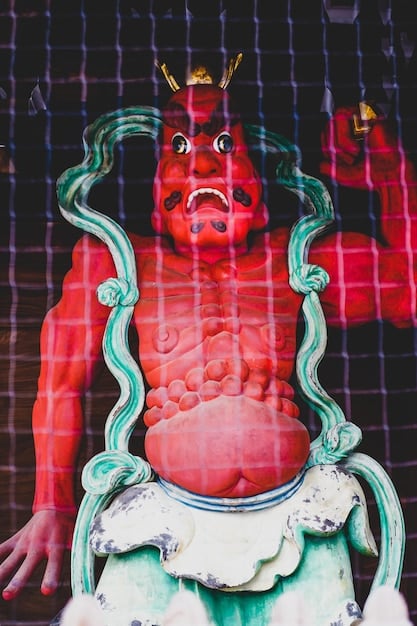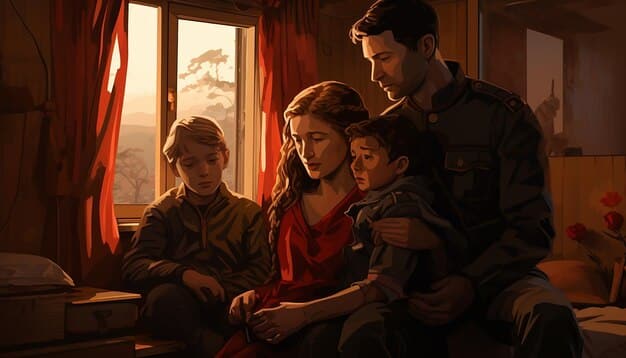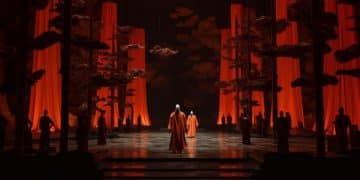Exploring Japanese Drama Genres: From J-Horror to J-Romance

Advertisements
Japanese drama genres offer a diverse range of storytelling, from the chilling narratives of J-Horror to the heartwarming stories of J-Romance, alongside genres like slice-of-life, historical dramas, and suspenseful thrillers, each providing a unique cultural and emotional viewing experience.
Japanese drama genres, often referred to as “dorama,” offer a captivating glimpse into Japanese culture and storytelling. From spine-chilling horror to heartwarming romance, and thought-provoking social commentaries, there’s a genre to suit every taste.
Anúncios
Delving into the chilling depths of J-Horror
J-Horror, or Japanese horror, has gained international recognition for its unique approach to the genre. Unlike Western horror, which often relies on gore and jump scares, J-Horror emphasizes psychological terror, atmosphere, and the supernatural.
It explores themes of societal anxieties, repressed emotions, and the blurring lines between the living and the dead.
Anúncios
Key Elements of J-Horror
Several key elements define the J-Horror genre, setting it apart from its Western counterparts.
- Onryō (Vengeful Spirits): Central to many J-Horror stories are onryō, spirits consumed by rage and seeking revenge.
- Psychological Terror: J-Horror focuses on creating unease and dread through atmosphere, sound design, and unsettling imagery rather than relying solely on graphic violence.
- Supernatural Entities: Ghosts, demons, and other supernatural beings play prominent roles, often with complex backstories and motivations.
- Everyday Settings: The horror often unfolds in familiar, mundane settings, making it more relatable and disturbing.
Classic J-Horror films such as “The Ring” (Ringu) and “The Grudge” (Ju-On) have redefined the horror genre, inspiring remakes and influencing horror filmmaking worldwide. These films masterfully create a sense of unease and dread, leaving a lasting impact on viewers. The effectiveness of J-Horror lies in its ability to tap into primal fears and cultural beliefs, making it a truly terrifying experience.
Embracing the Sweetness of J-Romance
J-Romance, or Japanese romance dramas, offer a heartwarming and often bittersweet exploration of love, relationships, and personal growth. These dramas often delve into the complexities of human connection, exploring themes of first love, unrequited feelings, and the challenges of maintaining a relationship.
While some J-Romance dramas adhere to classic romantic tropes, many offer a fresh perspective, exploring unconventional relationships and tackling difficult topics with sensitivity.
Hallmarks of J-Romance
Several elements distinguish J-Romance dramas, making them appealing to a wide audience.
- Shōjo Influence: Many J-Romance dramas are inspired by shōjo manga (manga targeted towards young girls), featuring charming characters, heartwarming storylines, and themes of self-discovery.
- Emphasis on Emotional Depth: J-Romance dramas often delve deeper into the emotional lives of their characters, exploring their vulnerabilities, insecurities, and personal struggles.
- Bittersweet Endings: Not all J-Romance dramas have happy endings. Some explore the pain of heartbreak, the challenges of long-distance relationships, or the acceptance of unrequited love.
- Focus on Character Development: Characters in J-Romance dramas often undergo significant personal growth, learning valuable lessons about love, friendship, and themselves.
Popular J-Romance dramas such as “Hana Yori Dango” and “Itazura na Kiss” have captivated audiences with their charming characters, heartwarming storylines, and exploration of the complexities of love. These dramas often feature strong female leads who defy societal expectations and pursue their dreams, inspiring viewers to embrace their own individuality. The enduring appeal of J-Romance lies in its ability to connect with viewers on an emotional level, offering a glimpse into the complexities and joys of human connection.
Exploring everyday life in J-slice-of-life dramas
J-slice-of-life dramas offer a realistic and relatable portrayal of everyday life in Japan. These dramas often focus on ordinary people navigating their daily routines, relationships, and personal challenges. They offer a glimpse into Japanese culture, values, and social norms.
Unlike genres that rely on high-stakes drama or fantastical elements, J-slice-of-life dramas find beauty and meaning in the mundane.

These dramas often explore universal themes of family, friendship, work, and personal growth, resonating with audiences from diverse backgrounds. They offer a comforting and often humorous look at the simple joys and challenges of navigating life. The beauty of J-slice-of-life dramas lies in their ability to find meaning in the ordinary, reminding viewers to appreciate the small moments that make up a life.
Unraveling mysteries with J-Suspense
J-Suspense dramas keep viewers on the edge of their seats with intricate plots, unexpected twists, and a constant sense of unease. They often explore themes of crime, justice, betrayal, and the dark side of human nature.
These dramas masterfully create a sense of tension, drawing viewers into a world of secrets and hidden agendas.
Key Characteristics of J-Suspense
Several characteristics define J-Suspense dramas, contributing to their captivating nature.
- Intricate Plots: J-Suspense dramas often feature complex storylines with multiple layers, keeping viewers guessing until the very end.
- Unexpected Twists: These dramas are known for their unexpected plot twists, challenging viewers’ assumptions and keeping them engaged.
- Psychological Thrills: J-Suspense dramas often rely on psychological thrills, exploring the inner workings of their characters’ minds and creating a sense of unease.
- Moral Ambiguity: Characters in J-Suspense dramas are often morally ambiguous, blurring the lines between good and evil.
Popular J-Suspense dramas such as “LIAR GAME” and “Unnatural” have garnered critical acclaim for their gripping storylines, complex characters, and exploration of social issues. These dramas often tackle difficult topics such as corruption, injustice, and the consequences of violence, prompting viewers to reflect on the complexities of the world around them. The effectiveness of J-Suspense lies in its ability to challenge viewers’ perceptions and keep them engaged until the very end.
Stepping back in time with J-Historical dramas
J-Historical dramas, also known as “Jidaigeki,” transport viewers to different eras of Japanese history, offering a glimpse into the lives of samurai, emperors, and commoners. These dramas often depict significant historical events, battles, and political intrigues.
They provide valuable insights into Japanese culture, traditions, and values.
Key Elements of J-Historical Dramas
Several key elements define J-Historical dramas, making them a captivating and informative form of entertainment.
- Samurai Culture: Many J-Historical dramas focus on the samurai class, exploring their code of honor, their battles, and their role in shaping Japanese history.
- Political Intrigue: These dramas often depict the political machinations and power struggles that shaped Japanese society.
- Cultural Traditions: J-Historical dramas showcase traditional Japanese customs, clothing, and social norms, providing viewers with a glimpse into the past.
- Epic Battles: Many J-Historical dramas feature epic battle scenes, showcasing the military prowess of the samurai and the scale of historical conflicts.
Popular J-Historical dramas such as “Oda Nobunaga” and “Ryomaden” have captivated audiences with their sweeping narratives, compelling characters, and depiction of significant historical events. These dramas often explore themes of loyalty, betrayal, and the sacrifices made in the pursuit of power, prompting viewers to reflect on the complexities of Japanese history. The power of J-Historical dramas lies in their ability to bring the past to life, offering viewers a captivating and informative glimpse into Japanese history and culture.
Exploring other popular Japanese drama subgenres
Beyond the main genres, Japanese drama offers a diverse range of subgenres that cater to a wide variety of tastes. These subgenres often blend elements from different genres, creating unique and engaging viewing experiences.
Some popular subgenres include:
Medical Dramas
These dramas focus on the lives of doctors and nurses in hospitals, exploring the challenges they face in treating patients and navigating the complex world of healthcare.
Legal Dramas
These dramas follow the lives of lawyers and legal professionals, exploring themes of justice, ethics, and the complexities of the legal system.
School Dramas
These dramas focus on the lives of students and teachers in schools, exploring themes of friendship, bullying, and the challenges of adolescence.
The diversity of Japanese drama subgenres ensures that there is something for everyone to enjoy, regardless of their preferences. From heartwarming romances to thrilling suspense stories, and thought-provoking social commentaries, Japanese drama continues to captivate audiences worldwide, offering a unique and enriching viewing experience. These subgenres allow for niche storytelling while still capturing a wide audience.
| Key Point | Brief Description |
|---|---|
| 👻 J-Horror | Psychological terror and vengeful spirits highlight fear. |
| ❤️ J-Romance | Heartwarming stories focusing on emotional connections. |
| 🎭 J-Slice of Life | Relatable depictions of everyday experiences in Japan. |
| ⚔️ J-Historical | Dramas set in past eras, showing samurai and events. |
Frequently Asked Questions
▼
J-Horror emphasizes psychological terror, utilizing atmosphere and supernatural elements to create unease, unlike Western horror’s reliance on gore.
▼
Common themes include first love, unrequited feelings, and personal growth within relationships, often influenced by shōjo manga’s heartwarming storylines.
▼
These dramas portray daily lives and ordinary people’s experiences, allowing viewers to connect with the characters and situations depicted.
▼
J-Suspense dramas usually contain intricate plots with unexpected twists and psychological thrills that keep viewers guessing until the end.
▼
Viewers gain insights into Japanese culture, traditions, and historical events, particularly samurai culture and political intrigues through J-Historical dramas.
Conclusion
Exploring the diverse landscape of Japanese drama genres offers a captivating journey through Japanese culture, emotions, and storytelling. From the chilling depths of J-Horror to the heartwarming stories of J-Romance, and the thought-provoking narratives of J-Suspense, there’s a genre to suit every taste, offering a unique and enriching viewing experience.





